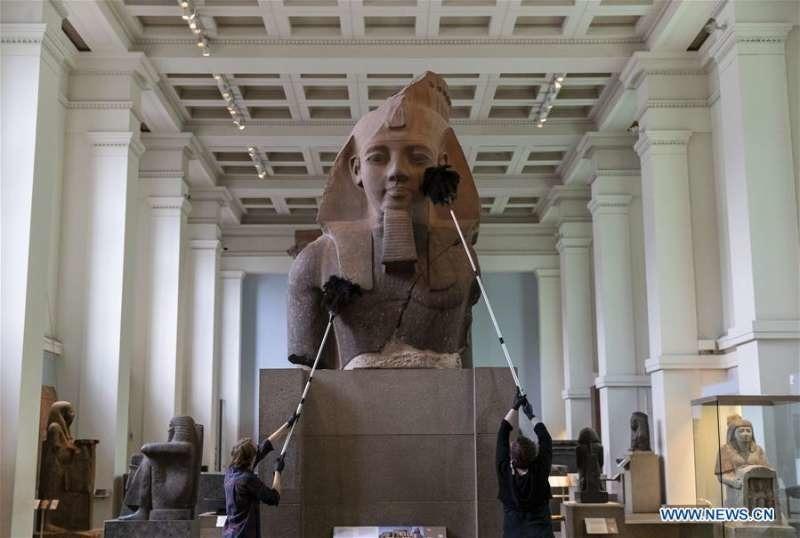 Workers dust off an exhibit ahead of the reopening of the British Museum in London in August last year. (HAN YAN / XINHUA)
Workers dust off an exhibit ahead of the reopening of the British Museum in London in August last year. (HAN YAN / XINHUA)
The United Kingdom's long and colorful history, which many tourists cite as a major reason for visiting, could become less vivid and less of a draw in a post-pandemic world because of the closure of some of the country's museums and historical sites.
Advocates say independent museums will be missed, having contributed US$1 billion to the UK economy in 2019 and almost 9,000 jobs
The facilities, many of which are run as charities or not-for-profit entities, rely heavily on revenue from ticket sales and have suffered greatly from lost income during lockdowns aimed at limiting the spread of the novel coronavirus.
Art Fund, an independent, membership-based charity that raises money to help buy important art and artifacts for the nation, said many of the around 1,600 small museums and art galleries in the UK are now close to becoming history themselves.
Jenny Waldman, the charity's director, told the BBC: "The latest lockdown is a body blow and is leaving our museums and galleries fighting for survival. Smaller museums in particular, which are so vital to their communities, simply do not have the reserves to see them through this winter."
ALSO READ: Palace Museum to launch cat-themed cartoon books
She said the lockdown, which prohibits almost all activity outside the home except for work, shopping for provisions, exercise and medical appointments, has left institutions without as much as 98 percent of their revenue, with bills still needing to be paid.
The situation forced London's Florence Nightingale Museum to announce its closure in early January.
The Williamson Art Gallery & Museum in Birkenhead is also facing imminent closure, and many other institutions are not far behind, she said.
Sky News said the situation forced London's Victoria and Albert Museum to announce that it would cut 103 jobs, or some 10 percent of its workforce. And the Birmingham Museums Trust has cut the equivalent of 48 full-time positions, around 25 percent of its roster.
Advocates say independent museums will be missed, having contributed £730 million (US$1 billion) to the UK economy in 2019 and almost 9,000 jobs.
Applying for grants
Waldman said Art Fund has set up an emergency response fund to try to keep museums and galleries going, but has been able to support only 15 percent of the institutions that have applied for grants, doling out £2.25 million.
The National Lottery's Heritage Fund has also been helping out, providing £1.1 billion to support 2,500 projects. It has invited small museums to apply for emergency grants of between £3,000 and£50,000.
But six in 10 museums, galleries and historic houses remain worried about their survival.
"Tragically, we are now seeing well-known and much-loved museums facing mothballing or permanent closure," Waldman said.
In November, artists including Anish Kapoor, Lubaina Himid, David Shrigley and Michael Landy donated works to a fundraising auction that aimed to raise money to support threatened facilities.
In Scotland, Glasgow Life, the charity that helps Scotland's largest city council provide culture and leisure facilities, said many of its venues are in similar trouble after the number of users fell from 18 million in 2019 to a trickle in 2020.
It said venues including Kelvingrove Art Gallery and Museum, the People's Palace, the Riverside Museum and the Mitchell Library have been hard hit.
"Without doubt, the effects of this crisis will be felt for some time to come," said Bridget McConnell, chief executive of Glasgow Life.
The UK government has responded by creating emergency grants and loans worth more than £1 billion, including £270 million of repayable finance and£880 million in grants.
"Repayable finance (for the loans) will be issued on generous terms tailored for cultural institutions to ensure they are affordable," the government said in a statement.
Prime Minister Boris Johnson said: "From iconic theater and musicals, mesmerizing exhibitions at our world-class galleries, to gigs performed in local basement venues, the UK's cultural industry is the beating heart of this country. This money will help safeguard the sector for future generations."
The intervention has been welcomed by advocacy organizations, including the Arts Council England and the Royal Opera House.
However, the fact that most of the money that is available must be paid back puts it beyond the reach of some facilities that are run on a shoestring.
One such museum, Dr Johnson's House near Fleet Street in London, is dedicated to the 18th-century lexicographer and literary giant Samuel Johnson and is run by Celine Luppo McDaid and her husband.
READ MORE: Tibetan treasures
They told the Evening Standard newspaper that the pandemic could cause more damage than many earlier challenges. "The museum survived two world wars, which sets a precedent for surviving a crisis like COVID," McDaid said.
For those museums and galleries that do manage to survive, it will be hard to feel optimistic about the future, with many potential paying visitors from overseas likely to be unable to travel.
With such challenges, the specter of institutions going out of business and being forced to sell off collections at bargain-basement prices has become very real.


